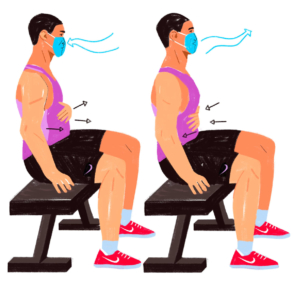Your face covering doesn’t have to take the wind out of your workout. Luckily, Nike has shared the following guide to help you get the most out of our exercise routine.

When gyms first reopened after COVID-related shutdowns, seeing someone wear a mask on the treadmill or by the squat rack may have seemed like an overly protective, even slightly paranoid, measure. Fast-forward to now, and many places — including Equinox — require facial coverings from the moment you step through the door to the second you leave. And for good measure: Studies have found that wearing masks in public can reduce the risk of virus contamination by blocking the transmission of virus-carrying droplets that someone can expel in the air and on surfaces.
“During indoor exercise, masks are even more important to reduce the spread of airborne particles throughout a gym,” says Amerigo Rossi, EdD, an assistant professor of health and exercise science at Long Island University. That’s because “during rest, we exhale about 250 milliliters per second, whereas during intense exercise, we might exhale about 3,000 milliliters per second. The force and volume of exhaled air is much greater” — meaning there are more chances for an unknowing party to pass something on.
To maximize your safety, Rossi suggests extending your typical physical distancing to 12 feet whenever possible and, of course, wearing a mask at all times. If the latter part feels harder than the first, read this and breathe a little easier.

1. Trust that air flows through the fabric
Anyone who’s ever done more than stand in a surgical or cotton mask knows that exercising in one can feel a bit stifling, to say the least. But the reason isn’t that you’re being deprived of oxygen. It’s that when you’re breaking a sweat while wearing a mask, the mask traps some of the heat your body is trying to lose as your core temperature increases. This could prevent your body from efficiently cooling itself, says Christopher Lundstrom, PhD, a lecturer on sport and exercise science at the University of Minnesota. You are unlikely to overheat just from wearing a mask, but your brain will sense that increase in temperature and cause you to slow down, he says. Your workout might subsequently feel harder, which is totally OK, he adds, as long as you pay attention to your body and don’t push too hard in hot and/or humid conditions.
If that doesn’t give you much relief, know that the smothered feeling is just that, a feeling. “When we exhale normally, air leaves in a fairly linear direction, so we are sure that we have exhaled,” says Rossi. “But in a mask, air also goes out through the sides and travels over our face, which can make us feel claustrophobic.”
2. Extend your rest breaks
If you’re just getting used to wearing a mask during any sort of physical activity, “it might take a little bit longer for you to recover, catch your breath, and feel ready to go again,” says Lundstrom. Your mind and body simply need to get accustomed to slightly warmer and stuffier circumstances. Multiply your normal rest time by 1.5 (e.g. if your usual interval recovery time is 1 minute long, tack on another 30 seconds between sets), suggests Lundstrom. Or use the talk test: You’ll know when you’re ready to push when you can comfortably speak again.
Even when you’re on the treadmill or stationary bike or doing some other steady-state activity, don’t be afraid to slow down for an active-recovery break if you feel lightheaded or dizzy. That could be a sign that you’ve subconsciously changed your normal breathing pattern because the mask feels “different,” says Rossi.
3. Focus on deep, belly breathing
More on that breathing-pattern bit: Sometimes when we feel like we can’t get enough air, our breath becomes shallow, explains Rossi. Labored breathing, which mainly relies on the chest and neck muscles, can unnecessarily increase your heart rate, feelings of anxiety, and fatigue, he says. All of these symptoms not only make it tough for you to relax and find your flow, they can also increase your rate of perceived exertion, or how hard you think you’re working, which can make you want to bow out early. To prevent panicked breathing during exercise, try counting your breath to keep it steady and consistent. Inhale for 2 to 3 seconds, then exhale for the same amount of time.
And when you’re resting between work intervals or after your workout, slow everything down by using diaphragmatic breathing, aka “belly breathing.” Take slow inhales through your nose as you feel your belly expand, then let your belly fall as you gradually exhale through your mouth. This can help you reset in less time.
4. Bring an extra mask
Thanks to sweat and all the moisture you produce when you exhale, it can get pretty damp underneath your face covering. “If your mask is totally soaked, it’s going to be really hard to breathe,” says Lundstrom. “It will lose its porous quality and could potentially block the optimal exchange of oxygen and carbon dioxide.” Your move? Bring two masks to every training session so you can switch to a dry one when you feel the first one getting soggy. Better yet, just throw a bunch in your gym bag.
While mask life probably isn’t going anywhere anytime soon, the upside is that training with one does get easier. Like any other physical challenge you throw at it, your body eventually adapts. But if you aren’t convinced, exercise outside whenever possible. There you can easily practice physical distancing, remove your mask when no one’s around, and more safely take in the great outdoors.
Thank you to Adele Jackson-Gibson for her words and Ryan Jackson for his illustrations. The full article can be found here. Nike products are available at Foot Locker and Champs. Call (305) 935-1110 to speak with an associate.